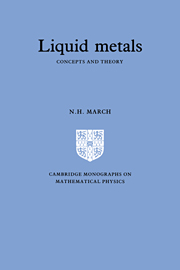Book contents
- Frontmatter
- Contents
- Preface
- 1 Outline
- 2 Pair correlation function and structure factor of ions
- 3 Thermodynamics
- 4 Electron screening and effective ion-ion interactions
- 5 Interionic forces and structural theories
- 6 Statistical mechanics of inhomogeneous systems and freezing theory
- 7 Electronic and atomic transport
- 8 Hydrodynamic limits of correlation functions and neutron scattering
- 9 Critical behaviour
- 10 Electron states, including critical region
- 11 Magnetism of normal and especially of expanded liquid metals
- 12 Liquid-vapour surface
- 13 Binary liquid-metal alloys
- 14 Two-component theory of pure liquid metals
- 15 Shock-wave studies
- 16 Liquid hydrogen plasmas and constitution of Jupiter
- Appendices
- References
- Index
11 - Magnetism of normal and especially of expanded liquid metals
Published online by Cambridge University Press: 19 January 2010
- Frontmatter
- Contents
- Preface
- 1 Outline
- 2 Pair correlation function and structure factor of ions
- 3 Thermodynamics
- 4 Electron screening and effective ion-ion interactions
- 5 Interionic forces and structural theories
- 6 Statistical mechanics of inhomogeneous systems and freezing theory
- 7 Electronic and atomic transport
- 8 Hydrodynamic limits of correlation functions and neutron scattering
- 9 Critical behaviour
- 10 Electron states, including critical region
- 11 Magnetism of normal and especially of expanded liquid metals
- 12 Liquid-vapour surface
- 13 Binary liquid-metal alloys
- 14 Two-component theory of pure liquid metals
- 15 Shock-wave studies
- 16 Liquid hydrogen plasmas and constitution of Jupiter
- Appendices
- References
- Index
Summary
Following the discussion of electron states in the previous chapter, the focus here will be the magnetic properties of liquid metals, both near to their melting points and along the coexistence curve towards the critical point.
In discussing the magnetism of normal metals, it has been traditional to separate the magnetic susceptibility into three contributions:
Core diamagnetism
Pauli spin susceptibility
Conduction electron orbital diamagnetism
Available evidence is that (1) can be dealt with adequately and thus it will be treated only in passing. The interest in (2) turns out, at least for simple s-p metals, to focus on the role of electron-electron interactions in enhancing the independent electron Pauli susceptibility. Contribution (3), as will be seen, is also of interest from the point of view of neutron scattering studies on a solid metal like Ni. The discussion will also embrace nuclear magnetic resonance and, in particular, the Knight shift in liquid metals.
Following this, which is centred on liquid metals just above their melting points, some consideration will also be given to the magnetic properties of expanded liquid metals. Here both phenomenology and also a treatment that leans on heavy Fermion theory (see Appendix 11.1) will be developed in order to interpret the properties of expanded liquid Cs, in particular, taken up toward the critical point along the coexistence curve.
Spin susceptibility of normal liquid metals
The most elementary theory of the spin susceptibility of a liquid metal follows that given in the early days of metal physics theory by Pauli.
- Type
- Chapter
- Information
- Liquid MetalsConcepts and Theory, pp. 147 - 179Publisher: Cambridge University PressPrint publication year: 1990



